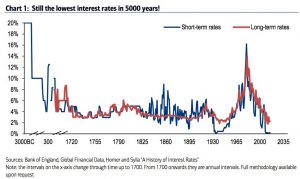In this ‘Brexit’-week, there is much talk from both the ‘stay’ and the ‘leave’ camp about the ‘historic’ proportion of this referendum in the UK.
It’s an important crossroad for Great Britain and Europe, no question. But I’m not so sure, the impact of a ‘leave’-vote would be that dramatic in the long run as currently projected. Only time will tell, if this vote will have a truly historic impact.
If you want to know something truly historic that happens right now, then look at the astonishing history investors are living through today. According to ‘Bank of America Merrill Lynch‘, interest rates are at their lowest levels in 5’000 years.
The chart below shows the lowest global interest rates going all the way back to 3’000 B.C.
Michael Hartnett, chief investment strategist at Bank of America Merrill Lynch, says that’s down to a combination of quantitative easing, zero interest-rate policies and negative interest-rate policies.
That means borrowing costs are lower than what was on offer at the time of the Pharaohs of the First Dynasty of Egypt (3’000 B.C.) to Napoleon through to and right up to those living through the crash of 1929 and World War II. Let’s have a look at the interest rates over the last 5’000 years:
- Mesopotamia, c. 3000 BC: 20%
- Babylon, Code of Hammurabi, 1772 BC: codified earlier Sumerian custom of 20%.
- Persian conquest (King Cyrus takes Babylon), 539 BC: rates of 40+%.
- Greece, Temple at Delos, c. 500 BC: 10%
- Rome, Twelve Tables, 443 BC: 33%
- Athens/Rome: circa the first two Punic Wars, 300-200 BC: 8%
- Rome: 1 AD: 4%
- Rome, under Diocletian, 300 AD: 15% (estimated)
- Byzantine Empire, under Constantine, 325 AD: limit 12.5%
- Byzantine Empire, Code of Justinian, 528 AD: limit 8%
- Italian cities, c. 1150: 20%
- Venice, 1430s: 20%
- Venice, (Leonardo da Vinci paints “The Last Supper in Milan”), 1490s: 25%
- Holland, beginning of the Eighty Years’ War, 1570s: 13%
- England, 1700s: 92%
- US, West Florida annexed by the US, 1810s: 64%
- US, circa World War II, 1940s: 85%
- US, Reagan administration, 1980s: 84%
- US, Fed does first rate hike in a decade in December 2015: 25-0.5%
- Japan, Europe, Bank of Japan and the European Central Bank implement a Zero interest-rate policy(ZIRP) and negative interest-rate policy(NIRP) in 2016.

The lowest rates in 5’000 years. How this happened and what are the consequences?
- Since ‘Lehman’ (September 2008), central banks have cut interest rates 550 times or once every 3 trading days.
- When cutting interest rates to historically low levels failed to revive growth, central banks took to so-called quantitative easing: injecting liquidity into economies by buying long-term government and other bonds. It did some good, but mostly the sellers sat on the cash instead of spending or investing it.
- Rates have fallen to levels that would have seemed unimaginable a couple of years ago, and few see them rebounding any time soon.
- The central banks of Denmark, Sweden, Switzerland, Japan, and the ECB have implemented negative rates. To revive the economy, or in the case of the Swiss National Bank (SNB) for instance, to keep the Swiss franc from strengthening against the EUR and protect swiss exporters. So when the ECB goes negative, the SNB must go even more negative.
- With a negative interest rate, the lender pays the borrower and investors stare at a growing pool of subzero bond yields and continued ultralow interest rates.
- After Germany’s benchmark 10-year government bond a week ago joined the negative-yield club, assets of over 10 trillion USD worth of sovereign bonds across the world ‘offer’ negative yields.
- Low interest rates are squeezing pension plans around the world. Many European governments are struggling to finance their social security systems, the first plank of every retirement plan.
- Tighten the belt: Negative rates and ever-rising life spans put the financial health of pension fundsat risk, so they moving to curb their liabilities by limiting payouts to retirees. In the Netherlands, which has Europe’s largest pension system by far in proportional terms, pension funds have warned that they may have to cut benefit payments to existing retirees next year.
Or, as the ‘Wall Street Journal’ recently concluded: “The insurance industry seems to be whistling past the graveyard.”
Find much more historic data about long-run trends in the return, volatility, valuation & ownership of financial assets, interest rates & bond yields, economic growth, inflation & debt in the complete report titled ‘The Longest Pictures’:
———-
Truly historic: from Mesopotamia (land between rivers) and the Pharaos in ancient Egypt to the digital world: interest rates have never been so low in 5’000 years.


Since the ‘Lehman Brothers’ bankruptcy (on Sept 15, 2008), central banks around the globe have cut interest rates 550 times.

 TheLeader Business, Economy, Stock Market, Management
TheLeader Business, Economy, Stock Market, Management
